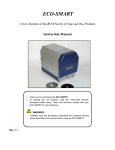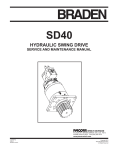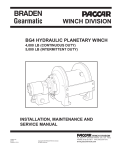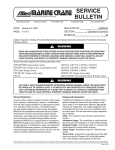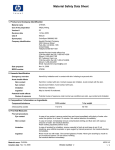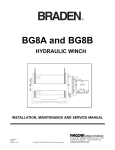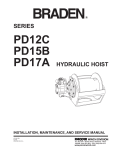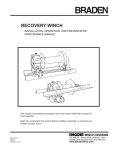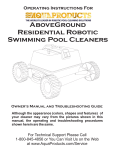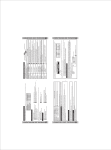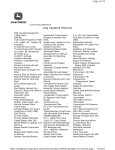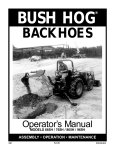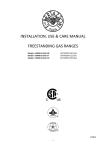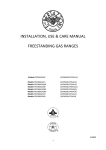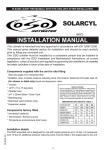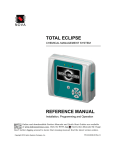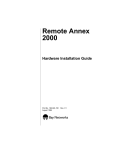Download BRADEN - Winches, Inc.
Transcript
BRADEN 2ND GENERATION “CH” SERIES PLANETARY HOISTS CH150A CH175A CH185A CH230A C2H150A C2H175A C2H185A C2H230A INSTALLATION, MAINTENANCE AND SERVICE MANUAL PACR WINCH DIVISION PB-154 8/99 Printed in U.S.A. P.O. BOX 547 BROKEN ARROW, OK U.S.A. 74013 PHONE (918) 251-8511 FAX (918) 259-1575 www.paccarwinch.com test TABLE OF CONTENTS FOREWORD . . . . . . . . . . . . . . . . . . . . . . . . . . . . . . . . . . . . . . . . . . . . . . .2 GENERAL SAFETY RECOMMENDATIONS . . . . . . . . . . . . . . . . . . . . . . . .3 BASIC OPERATION . . . . . . . . . . . . . . . . . . . . . . . . . . . . . . . . . . . . . . . . . .4 HOIST INSTALLATION . . . . . . . . . . . . . . . . . . . . . . . . . . . . . . . . . . . . . . . .6 WIRE ROPE INSTALLATION . . . . . . . . . . . . . . . . . . . . . . . . . . . . . . . . . . .6 WIRE ROPE WEDGES . . . . . . . . . . . . . . . . . . . . . . . . . . . . . . . . . . . . .7 HYDRAULIC CIRCUITS . . . . . . . . . . . . . . . . . . . . . . . . . . . . . . . . . . . . . . .8 RECOMMENDED BOLT TORQUES . . . . . . . . . . . . . . . . . . . . . . . . . . . . . .8 PREVENTIVE MAINTENANCE . . . . . . . . . . . . . . . . . . . . . . . . . . . . . . . . . .9 RECOMMENDED GEAR OIL . . . . . . . . . . . . . . . . . . . . . . . . . . . . . . . . . .10 TROUBLE SHOOTING . . . . . . . . . . . . . . . . . . . . . . . . . . . . . . . . . . . . . . .11 HOIST DISASSEMBLY . . . . . . . . . . . . . . . . . . . . . . . . . . . . . . . . . . . . . . .15 EXPLODED VIEW DRAWING AND PARTS KEY . . . . . . . . . . . . . . . . . . . .18 BRAKE CYLINDER SERVICE AND ASSEMBLY . . . . . . . . . . . . . . . . . . . .21 BRAKE CYLINDER TESTING . . . . . . . . . . . . . . . . . . . . . . . . . . . . . . .23 PLANET CARRIER SERVICE AND ASSEMBLY . . . . . . . . . . . . . . . . . . . .24 BRAKE CLUTCH SERVICE . . . . . . . . . . . . . . . . . . . . . . . . . . . . . . . . . . .27 HOIST ASSEMBLY . . . . . . . . . . . . . . . . . . . . . . . . . . . . . . . . . . . . . . . . . .29 REVERSING DIRECTION OF DRUM ROTATION . . . . . . . . . . . . . . . . . . .34 BRAKE VALVE SERVICE . . . . . . . . . . . . . . . . . . . . . . . . . . . . . . . . . . . . .36 METRIC CONVERSIONS . . . . . . . . . . . . . . . . . . . . . . . . . . . . . . . . . . . . .39 1 FOREWORD Read this entire publication and retain it for future reference. The following service instructions have been prepared to provide assembly, disassembly and maintenance information for the BRADEN Model CH series winch. It is suggested that before doing any work on these units, all assembly and disassembly instructions should be read and understood. Some pictures in this manual may show details or attachments that are different from your winch. Also, some components have been removed for illustrative purposes. Continuing product improvement may cause changes in your winch, which are not included in this manual. Whenever a question arises regarding your BRADEN Winch or this manual, please contact BRADEN Service Department at 1-918-2518511, 08:00 - 16:30 hours, CST, Monday through Friday, for the latest available information. MODEL NUMBER AND SERIAL NUMBER MODEL NUMBER AND SERIAL NUMBER When information on a hoist is needed, always refer to the model number and serial number. Both are located on the top of the motor side end plate as indicated above. EXPLANATION OF MODEL NUMBER CH 150 A - 23 090 01 G - 1 CONSTRUCTION HOIST CH 150 A 23 090 01 G 1 MAX RATING DESIGN MODEL GEAR RATIO MOTOR SIZE DRUM SIZE DRUM OPTION OPTION DESIGNATES CONSTRUCTION HOIST (C2H DESIGNATES TWO SPEED) DESIGNATES 15,000 LB FIRST LAYER LINE PULL DESIGNATES THE MODEL SERIES RELATING TO DESIGN CHANGES DESIGNATES TOTAL GEAR REDUCTION DESIGNATES HYDRAULIC MOTOR DISPLACEMENT IN CU IN/REV (DECIMAL POINT ELIMINATED EXAMPLE 090 – 9.0 CU IN/REV) DESIGNATES THE DRUM OPTION DESIGNATES OTHER DRUM OPTIONS (G = GROOVED; M = MACHINED; P = RATCHET AND PAWL; U = UNDERWOUND) PERMITS TESTING AND INSPECTION PRE API2C FOR OFFSHORE CRANES 2 GENERAL SAFETY RECOMMENDATIONS 1. Be certain equipment (boom, sheave blocks, pendants, etc.) is either lowered to the ground or blocked securely before servicing, adjusting, or repairing winch. 2. Be sure personnel are clear of work area BEFORE operating winch. 3. Read all warning and caution tag information provided for safe operation and service of winch. 4. Inspect rigging and winch at the beginning of each work shift. Defects should be corrected immediately. 5. Keep equipment in good operating condition. Perform scheduled servicing and adjustments listed in the “Preventive Maintenance” section of this manual. 6. An equipment warm-up procedure is recommended for all start-ups and essential at ambient temperatures below +40°F. Refer to “Warm-up Procedure” listed in the “Preventive Maintenance” section of this manual. 7. Do not exceed the maximum pressure (PSI) or flow (GPM) stated in the winch specifications. 8. Operate winch line speeds to match job conditions. 9. Leather gloves should be used when handling wire rope. 16. Use correct anchor for wire rope and pocket in drum. 17. Do not use knots to secure or attach wire rope. 18. The BRADEN designed wire rope anchors are capable of supporting the rated load when installed properly. For additional safety, ALWAYS maintain a minimum of five (5) wraps of wire rope on the drum. Safety and informational callouts used in this manual include: WARNING CAUTION ! ! WARNING – This emblem is used to warn against hazards and unsafe practice which COULD result in severe personal injury or death if proper procedures are not followed. 10. Never attempt to handle wire rope when the hook end is not free. 11. When winding wire rope on the winch drum, never attempt to maintain tension by allowing wire rope to slip through hands. Always use “Hand-Over-Hand” technique. ! CAUTION CAUTION ! CAUTION – This emblem is used to warn against potential or unsafe practices which COULD result in personal injury and product or property damage if proper procedures are not followed. 12. Never use wire rope with broken strands. Replace wire rope. 13. Do not weld on any part of the winch. 14. Use recommended hydraulic oil and gear lubricant. 15. Keep hydraulic system clean and free from contamination at all times. 3 BASIC OPERATION DESCRIPTION OF HOIST The static brake system has three operating components: The 1. 2. 3. 4. 5. 6. 7. 8. 9. 10. 1. Spring Applied, Multiple Friction Disc Static Brake 2. Brake Clutch Assembly 3. Hydraulic Piston and Cylinder hoist is made up of the following sub-assemblies: Hydraulic motor and brake valve Drum, drum closure, ball bearings and oil seals Support end plate and bearing support Motor end plate and motor adapter Tie plates Brake clutch assembly Brake cylinder assembly and multiple-disc brake parts Primary planetary reducer Secondary planetary reducer Ring gear and adapter Figure 2 Motor Static Brake To Tank Brake Valve THEORY OF OPERATION Pump The primary sun gear, being coupled to the hydraulic motor by the inner race of the brake clutch assembly, turns with the motor. As the primary sun gear turns, the primary planet gears, which are meshed with the primary sun gear and ring gear, walk around the stationary ring gear, causing the primary carrier to turn in the same direction as the motor shaft, but at a reduced speed. The primary carrier is meshed with the output sun gear which, therefore, turns in the same direction and at the same speed as the primary carrier. The output sun gear causes the output planet gears to walk around the ring gear, turning the output carrier and drum in the same direction as the primary carrier, but at a further reduced speed. Control Valve Low Pressure Medium Pressure High Pressure Figure 3 Motor Static Brake To Tank Brake Valve DUAL BRAKE SYSTEM – DESCRIPTION Pump The dual brake system consists of a dynamic brake system and a static brake system. Control Valve The dynamic brake system has two operating components: Low Pressure Medium Pressure High Pressure 1. Brake valve assembly 2. Hydraulic motor Figure 4 Motor Static Brake The brake valve is basically a counterbalance valve. It contains a check valve to allow free flow of oil to the motor in the hoisting direction and a pilot operated, spring-loaded spool valve that blocks the flow of oil out of the motor when the control valve is placed in neutral. When the control valve is placed in the lowering position, the spool valve remains closed until sufficient pilot pressure is applied to the end of the spool to shift it against spring pressure and open a passage. After the spool valve cracks open, the pilot pressure becomes flow-dependent and modulates the spool valve opening which controls the lowering speed. See figures 2, 3 and 4 Brake Valve To Tank Pump Control Valve Low Pressure Medium Pressure High Pressure 4 The static brake is released by the brake valve pilot pressure at a pressure lower than that required to open the pilot operated spool valve. This sequence assures that dynamic braking takes place in the brake valve and that little, if any, heat is absorbed by the friction brake. When lowering a load very slowly for precise positioning, no oil flow actually occurs through the winch motor. The pressure will build up to a point where the brake will release sufficiently to allow the load to rotate the motor through its own internal leakage. This feature results in a very slow speed and extremely accurate positioning. The friction brake is a load holding brake only and has nothing to do with dynamic braking or rate of descent of a load. The friction brake receives very little wear in the lowering operation. All of the heat generated by the lowering and stopping of a load is absorbed by the hydraulic oil where it can be readily dissipated. The brake clutch is splined to the primary sun gear shaft between the motor and the primary sun gear. It will allow this shaft to turn freely in the direction to raise a load and lock up to force the brake discs to turn with the shaft in the direction to lower a load. Figures 5 and 6. Static Friction Brake Applied Figure 5 The hydraulic cylinder, when pressurized, will release the spring pressure on the brake discs, allowing the brake discs to turn freely. Sprag Cams DUAL BRAKE SYSTEM – OPERATION When hoisting a load, the brake clutch which connects the motor shaft to the primary sun gear, allows free rotation. The sprag cams lay over and permit the inner race to turn free of the outer race. Figure 5. The friction brake remains fully engaged. The winch, in raising a load, is not affected by any braking action. Figure 2. Hoisting When the lifting operation is stopped, the load attempts to turn the primary sun gear in the opposite direction. This reversed input causes the sprag cams to instantly roll upward and firmly lock the shaft to the fully engaged friction brake. Figure 6. Permits free shaft rotation while hoisting When the winch is powered in reverse, to lower the load, the motor cannot rotate until sufficient pilot pressure is present to open the brake valve. Figures 3 & 4. The friction brake within the winch will completely release at a pressure lower than that required to open the brake valve. The extent to which the brake valve opens will determine the amount of oil that can flow through it and the speed at which the load will be lowered. Increasing the flow of oil to the winch motor will cause the pressure to rise and the opening in the brake valve to enlarge, speeding up the descent of the load. Decreasing this flow causes the pressure to lower and the opening in the brake valve to decrease thus slowing the descent of the load. Figure 6 Static Friction Brake Applied Sprag Cams Stopped, Holding Load When the control valve is shifted to neutral, the pressure will drop and the brake valve will close, stopping the load. The friction brake will engage and hold the load after the brake valve has closed. Load attempts to rotate shaft in opposite direction. Brake clutch locks sun gear shaft to friction brake. 5 INSTALLATION GENERAL REQUIREMENTS 1. The hoist should be mounted with the centerline of the drum in a horizontal position. The mounting plane can be rotated to any position around this centerline. 6. The hoist directional control valve must be a three-position, fourway valve with a motor spool such that when the valve is in the center position both work ports are opened directly to tank. 2. When mounting the hoist, use at least grade five bolts and nuts, and use both mounting holes in each end gate. 7. The hydraulic oil filter should have a 10 micron nominal rating and be a full-flow type. 3. It is important that the hoist be mounted on a surface that will not flex when the hoist is in use, since this could bind the working parts of the hoist. Also, be sure the hoist is mounted on a flat surface. If necessary, use shim stock to insure proper mounting. The mounting surface should be flat within + or -.020 inches. 8. High quality hydraulic oil is essential for satisfactory performance and long hydraulic system component life. Oil having 150 to 330 SUS viscosity at 100°F (38°C) and viscosity index of 100 or greater will give good results under normal temperature conditions. The use of an oil having a high viscosity index will minimize cold-start trouble and reduce the length of warm-up periods. Ahigh viscosity index will minimize changes in viscosity with corresponding changes in temperature. 4. Hydraulic lines and components that operate the hoist should be of sufficient size to assure minimum back pressure at the hoist. The motor manufacturer recommends that the back pressure not exceed 100 psi for maximum motor seal life. 150 psi is the maximum allowable back pressure. The standard CH150A, CH175A, CH185A, CH230A, C2H150A, C2H175A, C2H185A and C2H230A hoists are supplied with the motor internally drained. If high back pressures are encountered, the motor can be drained directly to tank to improve motor seal life. To insure adequate static brake load holding ability, back pressure on the hoist should not exceed 200 psi. For pressures exceeding 200 psi, consult Braden Engineering. Maximum cold weather start-up viscosity should not exceed 5000 SUS with a pour point at least 20°F lower than the minimum temperature. Under continuous operating conditions the temperature of the oil at any point in the system must not exceed 180°. 120-140°F is generally considered optimum. In general terms; for continuous operation at ambient temperatures between 50 and 110°F, use SAE 20W; for continuous operation between 10 and 90°F, use SAE 10W; for applications colder than 10°F, contact the BRADEN Service Department. The use of multi-viscosity oils is generally not recommended. 5. Make certain that the hoist drum is centered behind the first sheave and the fleet angle does not exceed 1 ½ degrees. The hoist should also be mounted perpendicular to an imaginary line from the center of the drum to the first sheave to insure even spooling. WIRE ROPE INSTALLATION ! WARNING CAUTION vent core slippage or loss of rope lay. ! Take the free end of the wire rope and insert it through the small opening on the cable drum. Loop the wire rope and push the free end about 3/4 of the way back through the pocket. Install the wedge as shown in figure 7, then pull the slack out of the wire rope. The “dead” end of the rope needs to extend slightly beyond the end of the wedge as shown in figure 8. THE CABLE ANCHORS ALONE ON HOISTS ARE NOT DESIGNED TO HOLD RATED LOADS. Winch loads applied directly to the wire rope anchor may cause the wire rope to pull free and result in the sudden loss of load control and cause property damage, personal injury or death. A minimum of 3 wraps of wire rope must be left on the drum barrel to achieve rated load. Using a hammer and brass drift, drive the wedge as deep into the pocket as possible to ensure it is fully seated and no further movement is detected. Applying a load on the wire rope will also help seat the wedge in the pocket. The wedge and anchor pocket must be clean and dry. The end of the wire rope being anchored to the drum must be clean and dry and not frayed. Anything on the end of the wire rope to keep it from fraying (i.e. tape or wire) must not be in contact with the wedge when the installation is complete. Consult the wire rope manufacturer on the proper treatment of the dead end of the wire rope. Some rope manufacturers recommend when using rotation resistant wire rope, that the rope end be seized, welded or brazed before inserting the wire rope into the wedge socket to pre- Check to ensure the wedge does not protrude from either end of the pocket, causing it to interfere with proper spooling of wire rope onto the drum (see figures 9 & 10). If there is interference or the wedge does not seat firmly, contact the Braden Product Support Department at 918-251-8511 to determine the proper wedge size. 6 It is important that the wire rope have the proper tensioning when it is installed on the drum. When the wire rope is first installed, you should operate the hoist, with light to moder- ate loads, with reeving that let’s you place these loads on the block and the drum with all the rope off the drum except for the last three wraps. Correct Installation Drive from this side Wedge and wire rope fully seated in pocket Figure 8 Figure 7 Incorrect Installations Wedge pulled too far through anchor pocket Wedge not fully seated • Wire rope not tight against wedge • Wedge may be too large • “Dead” end of wire rope and/or wedge may interfere with proper spooling • Wedge may be too small Figure 9 Figure 10 WIRE ROPE WEDGE PART NUMBERS WINCH MODEL WEDGE PART NO. CH150A, C2H150A, CH185A, C2H185A . 24493* for 7/16 thru 5/8 in. (11 - 16 mm); 24494 3/4 thru 1 in. (19 - 25 mm) CH230A and C2H230A . . . . . . . . . . . . . . 24493 for 7/16 thru 5/8 in. (11 - 16 mm); 24494* 3/4 thru 1 in. (19 - 25 mm) CH175A and C2H175A . . . . . . . . . . . . . . 24492* for 7/16 in. thru 7/8 in. (11 - 22 mm) * Standard Anchor 7 HYDRAULIC CIRCUITS SINGLE SPEED CIRCUIT 2 SPEED CIRCUIT WINCH ASSEMBLY W/BRAKE VALVE & STATIC BRAKE WINCH ASSEMBLY W/BRAKE VALVE & STATIC BRAKE BRAKE VALVE T P WINCH BRAKE BRAKE VALVE BR WINCH BRAKE BR A DR DR CONTROL VALVE 2-SPEED SELECTOR VALVE CONTROL VALVE PUMP PUMP RECOMMENDED BOLT TORQUE The general purpose torque shown in the chart applies to SAE Grade 5 bolts, studs and standard steel full, thick and high nuts. Higher or lower torques for special applications will be specified such as the use of spanner nuts, nuts on shaft ends, jam nuts and where distortion of parts or gaskets is critical. Lubricated torque values based on use of SAE 30wt engine oil applied to threads and face of bolt or nut. Bolt Dia. Inches 1/4 5/16 3/8 7/16 1/2 9/16 5/8 Thds per Inch 20 28 18 24 16 24 14 20 13 20 12 18 11 18 Bolt Dia. Inches Torque LB-FT Dry Lubed 9 6 3/4 18 13 7/8 31 23 1 50 27 1 1/8 75 55 1 1/4 110 80 1 3/8 150 115 1 1/2 8 Thds per Inch 10 16 9 14 8 14 7 12 7 12 6 12 6 12 Torque LB-FT Dry Lubed 265 200 420 325 640 485 790 590 110 835 1460 1095 1940 1455 PREVENTIVE MAINTENANCE A regular program of preventive maintenance for your planetary winch is strongly recommended to minimize the need for emergency servicing and promote safe, reliable winch operation. Field experience, supported by engineering tests, indicate the three (3) service procedures listed below are the MOST critical to safe, reliable winch operation and must be observed. • Regular Gear Oil Changes – every 1000 hours or six (6) months • Use of Proper Gear Oil – recommended type for prevailing ambient temperature • Annual Disassembly and Inspection of All Wear Items – in compliance with American National Standards Institute (ANSI) specification B30.5c 1987 and American Petroleum Institute (API) recommended practice RP 2D section 3. ating hours or six (6) months, whichever occurs first. The gear oil must be changed to remove wear particles that impede the reliable and safe operation of the brake clutch and erode bearings, gears and seals. Failure to change gear oil at these suggested minimum intervals may contribute to intermittent brake slippage which could result in property damage, severe personal injury or death. The following minimum service intervals are specified for operating hours of the prime mover. Oil Level Plug The gear oil should also be changed whenever the ambient temperature changes significantly and an oil from a different temperature range would be more appropriate. Oil viscosity with regard to ambient temperature is critical to reliable brake clutch operation. Our tests indicate that excessively heavy or thick gear oil may contribute to intermittent brake clutch slippage. Make certain that the gear oil viscosity used in your winch is correct for your prevailing ambient temperature. Failure to use the proper type and viscosity of planetary gear oil may contribute to brake clutch slippage which could result in property damage, severe personal injury or death. Refer to “Recommended Planetary Gear Oil” for additional information. 1. Oil Level The gear oil level should be checked every 500 operating hours or three (3) months, whichever occurs first. To check the oil level, remove the plug located in the drum support. The oil should be level with the bottom of this opening. If additional oil in needed, refer to “Recommended Planetary Gear Oil”. 3. Vent Plug The vent plug is located in the drum support as shown. It is very important to keep this vent clean and unobstructed. Whenever gear oil is changed, remove vent plug, clean in solvent and reinstall. Do not paint over the vent or replace with a solid plug. 4. Hydraulic System The original filter element should be replaced after the first fifty (50) hours of operation, then every 500 operating hours or three (3) months, or in accordance with the equipment manufacturer’s recommendations. 2. Oil Change 5. Wire Rope Inspect entire length of wire rope according to wire rope manufacturers recommendations. The gear oil should be changed after the first one hundred (100) hours of operation, then every 1,000 oper9 6. Mounting Bolts clutch slippage and damage to brake friction discs or seals. Oil viscosity with regard to ambient temperature is also critical to reliable brake clutch operation. Our tests indicate that excessively heavy or thick gear oil may contribute to intermittent brake clutch slippage. Make certain that the gear oil viscosity used in your winch is correct for your prevailing ambient temperature. Tighten all winch base mounting bolts to recommended torque after the first one hundred (100) hours of operation, then every 1000 operating hours or six (6) months, whichever occurs first. 7. Warm-up Procedures Awarm-up procedure is recommended at each start-up and is essential at ambient temperatures below +40°F (4°C). For simplicity, BRADEN has listed one (1) readily available product in each temperature range which has been tested and found to meet our specifications. This is not to say that other lubricant brands would not perform equally as well. The prime mover should be run at its lowest recommended RPM with the hydraulic winch control valve in neutral allowing sufficient time to warm up the system. The winch should then be operated at low speeds, forward and reverse, several times to prime all lines with warm hydraulic oil, and to circulate gear lubricant through the planetary gear sets. WARNING CAUTION ! If the following lubricant brands are not available in your area, make certain your lubricant vendor supplies you with oil that is equivalent to those products listed below. ! Failure to properly warm up the winch, particularly under low ambient temperature conditions, may result in temporary brake slippage due to high back pressures attempting to release the brake, which could result in property damage, severe personal injury or death. BRADEN planetary winches are factory filled with Texaco Meropa 150 or equivalent API GL-2/3 gear oil. 9. Inspection In compliance with ANSI specification number B30.5c1987 and API Recommended Practice RP 2D section 3, we recommend that the winch be disassembled for a thorough inspection of all wear items every 2,000 hours of operation or twelve (12) months, whichever occurs first. 8. Recommended Planetary Gear Oil Field experience, supported by extensive engineering tests, indicates the use of the proper planetary gear oil is essential to reliable and safe operation of the brake clutch and obtaining long gear train life. ! WARNING CAUTION A. Bearings and Gears – Refer to DISASSEMBLY OF WINCH, item17 on page 19; and PLANET CARRIER SERVICE, item 3 on page 20. ! B. Brake Cylinder – Refer to MOTOR SUPPORT – BRAKE CYLINDER SERVICE, Clean and Inspect, pages 22 and 23. Failure to use the proper type and viscosity of planetary gear oil may contribute to intermittent brake clutch slippage which could result in property damage, severe personal injury or death. Some gear lubricants contain large amounts of EP (extreme pressure) and anti-friction additives which may contribute to brake C. Brake Clutch – Refer to BRAKE CLUTCH SERVICE, item 4 on page 26. RECOMMENDED GEAR OIL PREVAILING AMBIENT TEMPERATURE oF -40 -30 -20 -10 0 10 20 30 40 50 60 70 80 90 100 110 120 130 oF TEXACO MEROPA 220 OR EQUIVALENT API GL-2/3 TEXACO MEROPA 150 OR EQUIVALENT API GL-2/3 MOBIL SHC 630 SYNTHETIC oC -40 -30 NOT RECOMMENDED FOR SEVERE APPLICATIONS SUCH AS: OFFSHORE CRANES, SUSTAINED FAST DUTY CYCLES OR FREQUENT LIFTING. -20 -10 0 10 10 20 30 40 50 oC TROUBLE SHOOTING ! WARNING CAUTION ! If a winch ever exhibits any sign of erratic operation, or load control difficulties (i.e. load creeping or chattering) appropriate troubleshooting tests and repairs should be performed immediately. Continued operation in this manner may result in property damage, serious personal injury or death. TROUBLE PROBABLE CAUSE REMEDY A The winch will not lower the load or not lower the load smoothly. 1. The problem could be a plugged or loose pilot orifice. The pilot orifice is a small pipe plug with a hole drilled through it, located behind the pilot port fitting on the brake valve. If it becomes plugged, it will prevent the pilot pressure, from the manifold, from opening the brake valve. If it becomes loose, it will allow an unregulated amount of oil in to operate the brake valve which cause erratic brake valve operation. Remove the pilot hose and fitting from the brake valve, then use a 5/32 inch Allen wrench to remove the pilot orifice. The diameter of the orifice is approximately .020 inches. Clean and install the pilot orifice tightly in the brake valve. 2. The friction brake may not be releasing as a result of a defective brake cylinder seal. Check brake cylinder seal as follows: A. Disconnect the swivel tee from the brake release port. Connect a hand pump with accurate 0-2000 psi gauge and shut-off valve to the –4 J.I.C. fitting in the brake release port. B. Apply 1000 psi to the brake. Close shut-off valve and let stand for five (5) minutes. C. If there is any loss of pressure in five (5) minutes, the brake cylinder should be disassembled for inspection of the sealing surfaces and replacement of the seals. Refer to “Motor Support-Brake Cylinder Service”. NOTE: If the brake cylinder seal is defective you will usually find oil leaking from the winch vent plug. 3. Friction brake will not release as a result of damaged brake discs. 11 Disassemble brake to inspect brake discs. Check stack-up height as described in “Motor Support-Brake Cylinder Service”. TROUBLE PROBABLE CAUSE REMEDY B Oil leaks from vent plug. 1. Same as A2. Same as A2. 2. Motor seal may be defective as a result of high system back pressure or contaminated oil. System back pressure must not exceed 150 psi. Inspect hydraulic system for a restriction in the return line from the control valve to the reservoir. Be sure control valve and plumbing is properly sized to winch motor. Oil analysis may indicate contamination has worn motor shaft and seal. Thoroughly flush entire hydraulic system and install new filters and oil. Install new motor seal. C The brake will not hold a load with the control lever in neutral. 1. Excessive system back pressure acting on the brake release port. The same as Remedy 2 of Trouble B2. 2. Friction brake will not hold due to worn or damaged brake discs. Same as Remedy 3 of Trouble A3. 3. Brake clutch is slipping. Improper planetary gear oil may cause the brake clutch to slip. Drain old gear oil and flush winch with solvent. Thoroughly drain solvent and refill winch with recommended planetary gear oil listed in “Preventive Maintenance”. Brake clutch may be damaged or worn. Disassemble and inspect brake clutch as described in “Brake Clutch Service”. D The winch will not hoist the rated load 1. 2. The winch may be mounted on an uneven or flexible surface which causes distortion of the winch base and binding of the gear train. Binding in the gear train will absorb horsepower needed to hoist the rated load and cause heat. System relief valve may be set too low. Relief valve needs adjustment or repair. 12 Reinforce mounting surface. If necessary, use shim stock to level winch. Refer to “Winch Installation”. First loosen, then evenly retighten all winch mounting bolts to recommended torque. Check relief pressure as follows: A. Install an accurate 0-4000 psi gauge into the inlet port of the brake valve. TROUBLE PROBABLE CAUSE TROUBLE “D” CONTINUED FROM PREVIOUS PAGE REMEDY B. Apply a stall pull load on the winch while monitoring pressure. C. Compare gauge reading to winch specifications. Adjust relief valve as required. NOTE: If pressure does not increase in proportion to adjustment, relief valve may be contaminated or worn out. In either case, the relief valve may require disassembly or replacement. 3. Be certain hydraulic system temperature is not more than 180 degrees F. Excessive hydraulic oil temperatures increase motor internal leakage and reduce motor performance. Same as remedies for Trouble D1 & D2. Winch line pull rating is based on 1st layer of wire rope. Refer to winch performance charts for additional information. 5. Rigging and sheaves not operating efficiently. Perform rigging service as recommended by crane manufacturer. 1. Same as D1. Same as remedies for Trouble D1. 2. Be certain that the hydraulic system temperature is not more than 180 degrees F. Excessive hydraulic oil temperatures may be caused by: A. Plugged heat exchanger. Thoroughly clean exterior and flush interior. B. Too low or too high oil level in hydraulic reservoir. Fill/drain to proper level. C. Same as D2. Same as remedies for Trouble D2. D. Hydraulic pump not operating efficiently. Prime mover low on horsepower or R.P.M. Tune/adjust prime mover. 4. E The winch runs hot. Same as remedies for Trouble E2. Check suction line for damage. If pump is belt driven, belts are slipping. Replace/tighten belts. Pump worn. Replace pump. 3. Excessively worn or damaged internal winch parts. 13 Disassemble winch to inspect/replace worn parts. TROUBLE PROBABLE CAUSE REMEDY F Winch “chatters” while raising rated load. 1. Same as D2. Same as remedies for Trouble D2. 2. Hydraulic oil flow to motor may be too low. Same as remedies for Trouble E2. 3. Controls being operated too quickly. Conduct operator training as required. 1. The winch may be mounted too close to the main sheave, causing the fleet angle to be more than 1½ degrees. Check mounting distance and fleet angle. Reposition winch as required. 2. The winch may not be mounted perpendicular to an imaginary line between the center of the cable drum and the first sheave. Refer to “Winch Installation”. 3. Could possibly be using the wrong lay rope. There is a distinct advantage in applying rope of the proper direction of lay. When the load is slacked off, the several coils on the drum will stay closer together and maintain an even layer. If rope of improper lay is used, the coils will spread apart each time the load is removed. Then, when winding is resumed, the rope has a tendency to crisscross and overlap on the drum. The result is apt to be a flattened and crushed rope. Consult wire rope manufacturer for recommendation of wire rope that best suits your application. 4. The winch may have been overloaded, causing permanent set in the wire rope. Replace wire rope and conduct operator/rigger training as required. G The wire rope does not spool smoothly on the drum. 14 DISASSEMBLY PROCEDURE FOR HOIST 1. Remove the wire rope from the hoist drum and align the drain plug in the drum with the hole in the support end plate before removing the hoses and mounting bolts. After the hoist is removed from its mounting, clean the outside surfaces. 4. Begin the disassembly by standing the hoist on the end opposite the motor. Tag and remove the hydraulic hoses that connect the brake valve and the motor (manifold in the case of a two-speed motor) to the brake release port. 2. To drain the oil, screw a short piece of 1” pipe into the larger threads of the drain hole. 5. Remove the four (4) capscrews and lockwashers securing the motor and lift the motor off the hoist. Remove and discard the O-ring installed on the outside of the motor pilot. 3. Use a 3/8” drive extension to remove the drain plug through the pipe. If the drain holes were not aligned before the hoist was removed from its mounting, the oil can be drained through the fill/vent plug in the bearing support by turning the hoist up on the bearing support end. 6. Remove the sixteen (16) capscrews and lockwashers (20 in the CH185A and C2H185A models) from the two (2) tie plates, and remove the plates. 15 7. Remove the tee fitting from the brake cylinder nipple. 11. Remove the brake plate spacer and brake and friction discs. 8. Remove the eight (8) capscrews and lockwashers from the motor adapter, and remove the motor adapter. Remove and discard the O-ring that was under the motor adapter. 12. Remove the brake cylinder assembly, and place it on a clean, dry surface so as not to damage the splines. Refer to the section on disassembly of the brake cylinder assembly. 9. Remove the brake cylinder nipple, then remove the motor end plate. 10. Remove the brake clutch assembly from the brake cylinder. Refer to the section on disassembly of the brake clutch assembly. 13. Next, remove the primary sun gear. 16 14. Remove the cable drum closure by using two (2) capscrews from the motor adapter and a short piece of chain. Lift the closure out of the drum. Remove and discard the O-ring and the seal. Inspect the bearing for wear. If replacement is necessary, use a bearing driver to remove the bearing. 17. Remove the primary planet carrier assembly. Refer to the section on disassembly of the primary planet carrier assembly. 18. Remove the thrust bearing that was under the primary planet carrier assembly, then remove the output sun gear. 15. Lift out the ring gear adapter. 19. Lift out the ring gear. Inspect the gear for abnormal wear or pitting. 16. Remove thrust bearing and two races. 17 20. Remove the output planet carrier assembly. You can make hooks like the ones shown to make removal easier. Refer to the section on disassembly of the output planet carrier assembly. 22. Turn the drum over and remove and discard the seal. Inspect the bearing in the end of drum. If replacement is necessary, use a bearing driver to remove the bearing. 21. Lift the drum off the support end plate. 23. Check the bearing support sealing surface for nicks and burrs. It is not necessary to remove the bearing support from the support end plate unless it has been damaged. 18 BRAKE CYLINDER SERVICE 3. Turn the brake cylinder on end with the large end up. Remove the spiral retaining ring and lift out the brake piston plate. 1. Turn the brake cylinder on end with the large end down. Use the special compression tool or a shop press to compress the backup plate in order to remove the retaining ring. ! CAUTION CAUTION ! CAUTION: Make certain that the threaded rod of the compression tool fully engages the lower plate. If a press is used, be careful not to damage any parts by applying too much pressure. Remove the retaining ring with snap ring pliers. Be careful to not let the pliers slip out of the retaining ring. Release the compression tool by holding the threaded rod stationary while backing off the nut. 4. Turn the brake cylinder over and pull the piston out. Remove and discard the O-rings. Inspect the backup rings for nicks or cuts, and replace if necessary. Be careful not to damage the O-ring groove surfaces. 2. Remove the spring guide. The backup plate, belleville springs and spring guide will come out together. Closely inspect the spring guide for damage that might prevent the springs from moving freely in an axial direction. Also inspect the springs for cracks and material displacement. Replace any defective parts. 5. Inspect the brake cylinder for nicks and scratches on the O-ring sealing area. Check the internal splines for notches that might prevent the brake discs from sliding freely. Be careful not to damage the O-ring sealing surfaces. 19 SECOND GENERATION CH SERIES EXPLODED VIEW AND PARTS KEY 45 46 46 42 69 43 71 41 64 72 59 29 40 27 28 30 29 38 31 36 37 101 62 38 35 32 55 37 26 102 100 34 65 39 58 70 4 53 57 8 54 5 74 6 56 7 24 10 68 13 9 11 18 12 17 15 21 76 20 19 67 3 66 14 73 2 61 50 43 137 60 136 49 48 43 51 129 135 140 1 3 3A 141 122 130 133 * These items NOT SERVICED SEPARATELY. Entire brake clutch assembly must be replaced. 134 131 143 142 128 127 132 125 123 126 Two Speed Motor (-1 option) 124 20 Refer to BRADEN Second Generation CH Series Material List (Publication 11-18) for part numbers. ITEM 2 3 4 5 6 7 8 9 10 11 12 13 14 15 17 18 19 20 21 24 26 27 28 29 29 30 31 32 34 35 36 37 38 39 40 41 42 DESCRIPTION Brake Cylinder Brake Piston Brake Piston Plate Backup Plate Belleville Spring Spring Guide Retaining Ring Snap Ring Snap Ring O-Ring O-Ring Backup Ring Backup Ring Street Elbow - 45o Outer Brake Race* Inner Brake Race* Snap Ring Sprag Bearing Retainer Sprag Clutch* Sprag Bearing Primary Planet Carrier Primary Planet Gear Primary Planet Gear Shaft Thrust Washer Thrust Washer Roller Bearing Spirol Pin Thrust Washer Output Planet Carrier Output Planet Gear Output Planet Gear Shaft Thrust Washer Roller Bearing Spirol Pin Support End Plate Bearing Support Capscrew QTY. 1 1 1 1 8 1 1 1 1 1 1 1 1 1 1 1 2 2 1 1 1 3 3 6 6 3 3 1 1 3 3 6 6 3 1 1 8 140 143 127 142 128 139 131 133 130 135 122 132 134 124 129 125 136 126 137 123 Single Speed Motor (-1 option) 21 ITEM 43 44 45 46 46 48 49 50 51 53 54 55 56 57 58 59 60 61 62 64 65 66 67 68 69 70 71 72 73 74 76 100 101 102 122 123 124 125 126 127 128 129 130 131 132 133 133a 134 135 135 136 137 139 140 142 143 DESCRIPTION Lockwasher Reducer Bushing Relief Valve Sight Glass Pipe Plug Motor End Plate Motor Adapter O-Ring Capscrew Ring Gear Ring Gear Adapter Primary Sun Gear Cable Drum Closure Output Sun Gear Thrust Washer Cable Drum Capscrew Tie Plate Bearing Spacer Ball Bearing Ball Bearing Brake Disc Friction Disc O-Ring Oil Seal Oil Seal Cable Anchor Wedge Plug Brake Plate Spacer Retaining Ring Pipe Nipple Bearing Race (.092" thick) Thrust Bearing Bearing Race (.063" thick) Hydraulic Motor Brake Valve O-Ring O-Ring Capscrew o Elbow Fitting (90 ) Hose Assembly Fitting o Elbow Fitting (90 ) Hose Assembly Tee Fitting Needle Valve Elbow Fitting (90o) Fitting Hose Assembly Tee Fitting Tee Fitting Plug Elbow Fitting (90o) Warning Tag Lockwasher Capscrew QTY. 36 1 1 1 1 1 1 1 8 1 1 1 1 1 1 1 16 2 3 1 1 10 9 1 1 1 1 1 1 1 1 1 1 1 1 1 1 1 4 1 1 1 1 1 1 1 1 1 1 1 1 1 1 1 4 4 BRAKE CYLINDER ASSEMBLY 5. Install the eight (8) belleville springs over the spring guide. The first one should rest against the snap ring on the spring guide, with the concave side facing the snap ring. The second spring should be installed with its convex side facing the snap ring. Alternate the remaining six (6) springs until all eight (8) are in place. 1. Lubricate O-rings and backup rings with oil and install them on the brake piston. The concave surface of the backdrop ring must be next to the O-ring. Let the assembly set for 10 minutes in order for the O-rings and backup rings to return to their original shape. 2. Here are the backup rings and O-rings installed correctly. The backup rings must be to the outside of the O-rings. 6. Next, place the backup plate over the spring guide so that it rests on the top spring. Then, insert the spring guide, springs and backup plate into the brake cylinder. 3. Lubricate the outside of the piston with oil or grease. 4. With the brake cylinder resting on its large end, insert the piston into the brake cylinder. Be careful not to cut the O-rings or backup rings. 22 7. Use a press or the special compression tool to compress the springs. Make certain the threaded portion of the compression tool fully engages the lower plate. Install the retaining ring using snap ring pliers. Be careful to not let the pliers slip out of the retaining ring. 9. Now pressure check the brake cylinder assembly with the hand pump connected to the 1/8” NPTF elbow in the top of the assembly. Apply 1000 psi and let the unit set for 5 minutes. If the gauge does not register a pressure drop, it means you have installed the O-rings and backup rings correctly. After making certain the retaining ring is in place, release the compression tool slowly, holding the threaded portion of the tool stationary, while backing off the nut. 8. Turn the assembly over and place the brake piston plate over the brake piston. Install the spiral retaining ring in the groove in the brake piston. 23 OUTPUT PLANET CARRIER SERVICE 3. To disassemble the primary planet carrier assembly, the steps are the same as for the output planet carrier assembly, except there is only one bearing for each gear. Also, the primary carrier has a thrust washer inside that can be removed after the planet gears are removed. 4. If the rollers show any sign of spalling, corrosion, discoloration, material displacement or abnormal wear, the bearing should be replaced. Likewise, the cage should be inspected for unusual wear or deformation, particularly the cage bars. If there is any damage that will impair the cage’s ability to separate, retain and guide the rollers properly, the bearing should be replaced. The thrust washer contact areas should be free from any surface irregularities that cause excessive abrasion or friction. The gears should be inspected for abnormal wear or pitting. Replace if necessary. 1. Drive the three (3) spiral pins into the center of the planet gear shafts. 2. Remove one (1) planet gear shaft, two (2) thrust washers, two (2) roller bearings and one (1) planet gear from each of three (3) locations in the carrier. The CH150A, C2H150A, CH175A and C2H175A also have a bearing spacer between each pair of bearings that has to be removed. 5. Use a punch to drive the spiral pins out of the planet gear shafts. The same surface and material conditions that are detrimental to the life of the bearings and thrust washers also apply to the contact areas on the shafts and carrier. 24 OUTPUT PLANET CARRIER ASSEMBLY 1. Insert two bearings into a gear (when assembling the output planet carrier assembly for a CH150A, C2H150A, CH175A or C2H175A, install a bearing spacer between the two bearings). Place a thrust washer on each side of the gear and install it in a carrier opening. Slide a shaft through the carrier, thrust washers, bearings and gear. 3. Drive a spiral pin into place. Note that it is slightly recessed in the carrier when it is in the proper position. Use a center punch to dent the carrier next to the hole as shown. This will distort the hole so the pin will not work itself out. Repeat these steps for each of the three planet gears. 2. Align the hole in the carrier and shaft so a spiral pin can be installed. Always use a new 3/16” x ¾” spiral pins when assembling these carriers. Use spiral pins, because they are much stronger than roll pins. 4. This is how the output planet carrier should look after you assemble it. To assemble the primary planet carrier assembly, the steps are the same as for the output planet carrier assembly, except there is only one bearing for each gear. Also, the thrust washer must be installed inside the carrier on the hub end before the planet gears are installed. 25 CLEAN AND INSPECT The thrust washer contact areas should be free from any surface irregularity that causes excessive abrasion or friction. Thoroughly clean all of the parts in a good grade of cleaning solvent; one that is not flammable, not toxic and will not cause skin rashes. If necessary, use rubber gloves. Finally, the shafts and carrier should be checked where there is roller or thrust washer contact. The same surface and material conditions that are detrimental to the life of the bearing and thrust washer also apply to the contact areas on the shaft and carrier. Inspect all parts for wear, nicks, scratches and damage that would render them unusable. If a part is questionable, it is better to replace it rather than take a chance on premature failure when the hoist is placed back in service. If the hoist was disassembled only to replace damaged seals after a short period of service, it is not necessary to replace the bearings. Experience and common sense, along with a good inspection, will determine if they can be used again. Always replace O-rings, seals and spiral pins. Sometimes it is permissible to reuse bearings and bushings . . . it depends on how much use they have had. Always coat O-rings, bearings, bushings and the rubber parts of seals with oil or grease during assembly. Use a sealing compound on the outside diameter of seals and a light coat of thread sealing compound or sealing tape on pipe fittings and plugs. Be careful not to get this compound or tape inside parts and passages which conduct oil. At regular service intervals, the cage and roller bearing assemblies and thrust washers in the planet carrier assemblies should be inspected to insure beyond any doubt that they will function properly when re-installed. The rollers should not exhibit any surface irregularities. If the rollers show any sign of spalling, corrosion, discoloration, material displacement or abnormal wear, the bearings should be replaced. Likewise, the cage should be inspected for unusual wear or deformation, particularly the cage bars. If there is any damage that will impair the cage’s ability to separate, retain and guide the rollers properly, the bearing should be replaced. 26 BRAKE CLUTCH SERVICE DISASSEMBLY 4. Next, slide the sprag clutch out, inspect the sprag clutch closely for abnormal wear, cracks, pitting or corrosion. Check small clips for breakage or bright spots; the signs of excessive wear. Unless the outer race or remaining sprag bushing is damaged or shows excessive wear, there is no need for further disassembly. If disassembly is necessary, remove the bushing according to the procedure covered in Step No. three (3). All brake clutch assembly parts should be thoroughly cleaned and inspected before assembly. 1. Remove the snap ring and sprag bushing retainer from one end only. ! WARNING CAUTION ! The polished surfaces of the races and sprag cams must be perfectly smooth to insure positive engagement of the clutch. The slightest defect may reduce brake clutch effectiveness, which could result in property damage, severe personal injury or death. It is generally recommended to replace the entire brake clutch assembly if any component is defective. 2. Pull the inner race out. Examine the race for scoring, wear or indentations caused by the sprag cams. If the inner race is not completely smooth, the entire brake clutch assembly must be replaced. ASSEMBLY 1. Press a sprag bushing into the outer race, using a mechanical or hydraulic press. A flat plate of approximately the same diameter as the bushing flange outside diameter should be placed between the press and bushing during assembly to protect the bushing. Be certain the bushing flange is against the shoulder in the outer race. 3. Use a screwdriver and mallet to remove the sprag bushing from one end of the outer race. There are four special cut-outs in the bushing for this purpose. Be careful not to damage the bushing inside surface. If a bushing’s inside surface is damaged or shows wear, replace it. 27 6. Turn the assembly over with the snap ring down. Install the second retainer and snap ring. Make certain the snap ring is seated in the groove properly. 2. Turn the assembly over and install the sprag clutch in the bore of the outer race. 3. Press the remaining bushing into the race. Again, make sure the bushing is against the shoulder. 4. Next, install a sprag bushing retainer, then a snap ring on the inner race. Be sure the snap ring is seated in the snap ring groove. 7. This is a completed brake clutch assembly. ! WARNING CAUTION ! Be certain the snap ring is seated in the groove in the splined bore of the inner race. This snap ring will keep the brake clutch assembly correctly positioned in the center of the friction brake pack. Binding of the brake or brake failure may occur if this snap ring is omitted. 5. Slide the inner race through the bushings and sprag clutch (the race will have to be rotated in the freewheeling direction to start it through the sprag clutch). If the inner race will not go through the bushings, the bushings have probably been damaged and should be replaced. 28 HOIST ASSEMBLY 3. Turn the drum over, and set it down on the bearing support. Be careful not to damage the seal when lowering the drum onto the bearing support. 1. Clean all parts before reassembling. The first step is to lay the support end plate down with the bearing support up. Lubricate the sealing and bearing lands on the bearing support. NOTE: If the bearing support was removed from the end plate, reinstall it with eight (8) capscrews and lockwashers, making certain two (2) large holes in the end plate line up with the cutouts in the bearing support. 4. Lower the output planet carrier assembly into the drum, making certain that the teeth on the carrier mesh with the teeth in the drum. 2. Install a new bearing in the drum if replacement is necessary, making certain to press it against the shoulder in the bottom of the bearing bore. Coat the outside diameter of the new seal with a good grade of sealant. Turn the spring side of the seal next to the bearing, and press the seal into the seal bore, leaving it flush with the surface shown. 5. Install the ring gear. The ring gear teeth must mesh with the output planet gears. 29 9. Install the ring gear adapter, hub end up, meshing the adapter with the ring gear. 6. Install the output sun gear and the thrust washer. Center the thrust washer on the output carrier so the primary carrier pilot can be installed in it. 10. Install a new bearing in the drum closure if replacement is necessary, making certain to press it against the shoulder in the bottom of the bearing bore. Coat the outside diameter of the new seal with a good grade of sealant. Turn the spring side of the seal toward the bearing, and press the seal into the seal bore, leaving it flush with the surface shown. Lubricate the new O-ring and install it on the drum closure. Lubricate the large diameter on the closure and install the closure in the drum. 7. Install the primary planet carrier assembly in the ring gear, meshing the planet gears with the ring gear. The hub goes down, engaging the output sun gear. Be sure the pilot enters the thrust washer. 8. Install thrust bearing and two race as shown. The thinner thrust race (.063 thick) goes next to the planet carrier and the thicker thrust race (.092 thick) goes next to the ring gear adapter. The needle thrust bearing of course goes between the two races. Not all units have this design revision using the thrust washer (see Parts Breakdown for details). 11. Install the primary sun gear, meshing its teeth with the primary planet gears. 30 15. Install the brake discs. Start with a brake disc and end with a brake disc. Alternate brake and friction discs until there are nine (9) of the friction discs and ten (10) of the brake discs. 12. Install the brake cylinder assembly over the primary sun gear, making certain the brake cylinder engages the ring gear adapter teeth. 16. Install the brake plate spacer on top of the brake discs. 13. Install the brake clutch assembly over the primary sun gear. When installed correctly, the outer race should turn freely in the same direction as the drum turns to spool wire rope out. For most Braden assemblies, this will be clockwise as viewed from the motor end. 17. Measure the brake stack-up as shown. The measurement should be a minimum of 3/16” from the top of the brake plate spacer to the top of the brake cylinder. If the measurement is less than 3/16”, remove the brake plate spacer and add a brake disc to the top of the brake package. Replace the brake plate spacer and repeat procedure. Do not exceed an overall height of ¼”. 14. Before installing the brake discs and friction discs, check their condition. Both kinds of discs should be flat and their teeth should not be pointed. The friction discs should have groove in the friction material. Replace discs, if necessary. 31 21. Install the tie plates next. Position the plates so that the curved part is toward the top of the hoist and curving away from the drum. Install the sixteen (16) capscrews and lockwashers (twenty for CH185A and C2H185A). 18. Install the motor end plate and then the brake cylinder nipple, using a good grade of thread sealant. 19. Lubricate the o-ring and install it on the outside of the brake cylinder. Push it down until it’s resting against the motor end plate. 22. Install the tee and hydraulic hoses at this time. Use a good grade of thread sealant, being careful not to get it in the hydraulic lines, as it could block an orifice in the brake valve. The long hose should point to the right as viewed from the motor end. 20. Install the motor adapter with eight (8) special BRADEN capscrews and lockwashers. 23. Lubricate and install a new O-ring around the pilot on the motor. 32 24. Engage the motor shaft in the brake clutch assembly inner race, and lower the motor into place. Install four (4) capscrews and lockwashers 26. After the hoist assembly is complete, check all capscrews and fittings to make certain they have been tightened correctly. Refill the hoist with the recommended oil listed under maintenance suggestions. 25. Install the hydraulic hoses as shown, then tighten. Continued on illustration no.26. 33 REVERSING DIRECTION OF DRUM ROTATION This procedure applies in general terms to standard hoists with Commercial Intertech gear motors. For information concerning hoists with other types of motors, consult the BRADEN Service Department at the phone number listed in the FOREWORD section of this manual. Motor Case Drain Lowering Port Drn “A” Motor Case Drain Brake Valve Hydraulic Motor Br Lowering Port Drn “B” M M = Manifold Block Brake Valve Hydraulic Motor M Br Hoisting Port Hoisting Port Brake Release Circuit Brake Release Circuit In order to change the direction of drum rotation, 2 things must be changed on the hoist. First, the motor must be made to rotate in the opposite direction. This is done by exchanging positions of the brake valve and manifold block on the motor. Secondly, the brake clutch assembly must be made effective for the opposite driection of rotation. This is done by reversing the brake clutch. Figures “A” and “B” above show typical motor installations. Note that the only difference between the two drawings is the motor is rotated 180o (the “belly” of the motor moves to the opposite side). If the motor shaft in figure “A” rotates clockwise when the hoisting port is pressurized, the motor shaft in figure “B” will rotate counterclockwise. 1. Stand the hoist up on the motor support with the motor up and secure in this position. Remove the four capscrews securing the brake valve to the motor. Remove the four capscrews securing the manifold block to the motor. Disconnect the motor case drain hose at the motor. NOTE: Some installations have the brake release hose connected directly to the motor, instead of to the manifold block as shown above. In these cases, disconnect the brake release hose from the motor. 2. Before removing the motor, it is a good idea to mark the position of the motor in relation to the hoist, since it will be rotatled 180o when re-installed. Remove the capscrews securing the motor to the hoist and carefully remove the motor. 4. Remove the snap ring and sprag bushing retainer from one end only of the brake clutch assembly. 3. Remove the brake clutch assembly from the hoist. Carefully inspect the splines on both ends of the inner race. a. If they are the same, the entire brake clutch assembly can be turned over and re-installed in the hoist. Before installing the brake clutch, be sure the inner race turns free in the same direction the drum will turn to haul-in wire rope. An easy way to check the rotation is to hold the outer race in one hand and rotate the inner race. Proceed to step 8. b. If the splines in each end of the inner race are not the same, proceed to step 4. 5. Pull the inner race out. Examine the race for scoring, wear or indentations caused by the sprag cams. If the inner race is not completely smooth, the entire brake clutch assembly must be replaced. 34 6. Turn the sprag assembly around and slide the inner race (with 1 snap ring and bushing retainer) through the bushing and sprag clutch (the race will have to be ratated in the free-wheeling direction to start it through the sprag clutch). Install the remaining bushing retainer and snap ring. Make sure the snap ring is properly seated in the groove. 7. Install the brake clutch assembly into the hoist. Before installing the brake clutch, be sure the inner race turns free in the same direction the drum will turn to haul-in wire rope. An easy way to check the rotation is to hold the outer race in one hand and rotate the inner race. 8. Install a new O-ring on the motor pilot. Rotate the motor 180o from its original position and install it onto the hoist. Install and tighten motor capscrews to recommended torque. 9. Install new O-rings in the brake valve and manifold block. Attach the brake valve and manifold block to the motor using the original capscrews and tighten to recommended torque. 10.Connect the motor case drain hose to the motor case drain port. NOTE: On two speed motors, the case drain and shift drain ports should be connnected directly to tank. DO NOT use the drain connection on the brake valve. Se “TWO SPEED MOTOR CASE DRAIN PLUMBING” for additional information. 11. If your hoist had the brake release hose connected directly to the motor, the original motor port must be plugged and the hose connected to the motor pressure port near the manifold block (lowering port). 12.Operate the winch slowly in both directions and check for oil leaks and/or unusual sounds. The hoist should operate smoothly in both directions. Refer to “WIRE ROPE INSTALLATION” and properly install wire rope onto the winch drum. 13.Before returning the hoist to full service, a light load should be lifted and held a few feet off the ground to be sure the static brake is functioning properly. The winch should also be able to slowly lower the load in a controlled manner. If the winch does not perform either of these functions, refer to “TROUBLE SHOOTING” FOR ADDITIONAL INFORMATION. 35 BRAKE VALVE SERVICE 1 1/2 INCH BRAKE VALVE 20 Standard Braden second generation CH series hoists are supplied with one of two types of brake valves. Both are reliable hydraulic valves with internal componentsmanufactured to close tolerances. Due to these close tolerances, several individual parts are not available as replacement parts and are noted in the following parts lists as NSS (Not Serviced Separately). Before disassembling the brake valve, be sure you have conducted all applicable trouble shooting operations and are certain the brake valve is causing the malfuntion. 0 11 10 11 10 19 19 19 1 12 2 14 4 Thoroughly clean the outside surfaces of the valve and work in a clean dust-free area, as cleanliness is of utmost importance when servicing hydraulic components. 8 1 1/4 INCH BRAKE VALVE 13 19 18 17 19 3 4 21 5 3 1 SEC. A-A 12 A 11 DRAIN PORT A 15 6 18 17 16 22 6 7 14 14 16 5 ITEM 9 8 7 10 2 4 ITEM 1 “BR” PORT 13 DESCRIPTION Valve Housing (NSS) 15 DESCRIPTION QTY. 1 Valve Housing (NSS) 1 2 Check Valve Retainer (NSS) 1 3 Spring Retainer (NSS) 1 4 Plug (NSS) 1 5 Spool (NSS) 1 6 Damper Piston (NSS) 1 7 Damper Piston Extension 1 8 Check Valve Poppet (NSS) 1 1 QTY. 10 Reducer 1 11 Check Ball 1 Check Valve Spring 1 1 2 Check Valve Retainer (NSS) 1 12 3 Spring Retainer (NSS) 1 13 Main Piston Spring 4 Plug (NSS) 1 14 O-Ring 1 15 Back-up Ring 1 16 O-Ring 1 17 Back-up Ring 1 18 O-Ring 1 19 Pipe Plug 1 20 Check Spring 21 Shim 22 Spring Seat 5 Spool (NSS) 1 6 Damper Piston (NSS) 1 7 O-Ring 1 8 Check Valve Poppet (NSS) 1 9 Pilot Orifice 1 10 Check Valve Spring 1 11 Spool Spring 1 12 O-Ring 2 13 O-Ring 1 14 O-Ring 1 15 Back-up Ring 1 16 Back-up Ring 1 17 Check Ball (1/4 in.) 1 18 Check Ball Spring 1 19 Elbow Fitting 1 1 as req'd 1 1 1/2 inch brake valves built after mid-March 1997 contain a spring seat (item 22) between the spool spring and the spool. This provides a slightly larger, more uniform area for the spring to seat against the spool. The result is increased spring service life and improved repeatability of pressure/flow modulation over the full compression range of the spring. 36 The spring retainer has been modified to allow for the additional thickness of the spring seat and a groove machined into the hex end cap serves as a visual indication that the valve contains the new spring seat. The spring seat improvement may be added to earlier brake valves by installing kit, Part Number 62805. Items 3, 7, 13, 14 and 22 are included in the kit. We recommend that this kit be installed whenever the brake valve is removed for inspection or service. 1 1/4 in. valve It is always a good practice to check the initial opening or “cracking” pressure of the brake valve whenever the hoist is serviced or inspected. Refer to Braden Service Bulletin 527 for complete brake valve test and adjustment procedures. 1 1/2 in. valve DISASSEMBLY 3. Remove the spool spring retainer and spool spring. Remove the spool plug and carefully remove the spool assembly. Remove the damper piston from the spool. The piston will come out of the spool slowly, because of a partial vacuum formed between the two. Use extreme care to avoid damaging the polished surfaces of either piece. 1. On the 1 1/4 inch valve only, remove the pilot orifice from the brake release (BR) port using a 5/32 inch Allen wrench 1 1/4 in. valve 1 1/4 in. valve 1 1/2 in. valve 1 1/2 in. valve 4. Remove the check valve spring retainer, spring and check valve poppet. 2. Remove the fitting, motor drain check ball and spring. 37 CLEAN AND INSPECT back-up ring is on the correct side of its O-ring. Take care not to cut the O-rings during assembly. Let the spool and piston set for ten (10) minutes before installing them into the brake valve housing. This will allow the O-rings to return to their original size after being stretched. 1. Discard all O-rings and back-up rings. Clean all parts in solvent and blow dry. Inspect polished surfaces of spool and damper piston for damage that may cause binding or leakage. Inspect spool bore in valve housing for damage or scoring. Inspect check valve seat in valve housing and check valve poppet. If the spools, bores or valves are damaged, the entire brake valve must be replaced. Check the free length of main piston spring. For the 1 1/4 inch valve, replace if less than 1 15/16 in. (49.2 mm) long. For the 1 1/2 inch valve, replace if less than 3 7/16 in. (87.3 mm) long. Check the free length of the check valve spring. Replace if less than 1 1/2 in. (38.1 mm) long. 2. Install new O-rings on the plug and spool retainers. 1 1/4 in. valve 1 1/4 in. valve 1 1/2 in. valve 2. Inspect the 0.020 inch (0.5 mm) orifice in the end of the spool to be certain it is open. On the 1 1/4 in. valve, also inspect the pilot orifice to be certain it is open. 1 1/2 in. valve 3. Lubricate the spool and damper piston O-rings with hydraulic oil. Carefully install the damper piston into the spool. Carefully install the spool into the valve housing. On either valve, always install the spool into the valve body from the plug end, so the O-ring enters the bore first. On the 1 1/4 inch valve, install the spool spring and spring retainer. On the 1 1/2 inch valve, install the spring seat, spool spring, damper piston extension and spring retainer. ASSEMBLY O-RING 1 1/4 in. valve 4. Install the check valve poppet, spring and check valve retainer. 5. Install the motor drain check ball, spring and fitting. BACK-UP RING 6. On the 1 1/4 inch valve only, install the pilot orifice into the “BR” port of the valve housing. O-RING 7. The brake valve is now completely assembled and ready to be installed on the winch motor. 1 1/2 in. valve BACK-UP RING 1. Install new O-rings and back-up rings on the spool and damper pistons as shown. It is important that each 38 METRIC CONVERSION TABLE English to Metric Metric to English LINEAR inches (in.) feet (ft.) miles (mi.) X 25.4 X 0.3048 X 1.6093 = millimeters (mm) = meters (m) = kilometers (km) millimeters (mm) meters (m) kilometers (km) X 0.3937 X 3.281 X 0.6214 = inches (in.) = feet (ft.) = miles (mi.) AREA 2 2 2 inches (sq.in.) feet2 (sq.ft.) X 645.15 X 0.0929 = millimeters (mm ) = meters2 (m 2) inches3 (cu.in.) quarts (qts.) gallons (gal.) inches3 (cu.in.) feet3 (cu.ft.) feet3 (cu.ft.) fluid ounce (fl.oz.) X X X X X X X 0.01639 0.94635 3.7854 16.39 28.317 0.02832 29.57 = liters (l) = liters (l) = liters (l) = centimeters3 (cc) = liters (l) = meters3 (m 3) = millileters (ml) ounces (oz.) pounds (lbs.) tons (2000 lbs.) tons (2000 lbs.) tons (long) (2240 lbs.) X X X X X 28.35 0.4536 907.18 0.90718 1013.05 = grams (g) = kilograms (kg) = kilograms (kg) = metric tons (t) = kilograms (kg) millimeters 2 (mm 2) meters2 (m 2) X 0.000155 = inches2 (sq.in.) = feet 2 (sq.ft.) X 10.764 VOLUME liters (l) liters (l) liters (l) centimeters3 (cc) liters (l) meters3 (m3) milliliters (ml) X X X X X X X 61.024 1.0567 0.2642 0.06102 0.03531 35.315 0.03381 = = = = = = = inches3 (cu.in.) quarts (qts.) gallon (gal.) inches3 (cu.in.) feet 3 (cu.ft.) feet 3 (cu.ft.) fluid ounce (fl.oz.) X X X X X 0.03527 2.2046 0.001102 1.1023 0.000984 = = = = = ounces (oz.) pounds (lbs.) tons (2000 lbs.) tons (2000 lbs.) tons (long) (2240 lbs.) X X X X X X 0.2961 0.145 14.22 14.5 4.0193 0.01 = inches Hg (60oF) = pounds/sq.in. (PSI) = pounds/sq.in. (PSI) = pounds/sq.in. (PSI) o = inches H2O (60 F) = bars MASS grams (g) kilograms (kg) kilograms (kg) metric tons (t) kilograms (kg) PRESSURE o inches Hg (60 F) pounds/sq.in. (PSI) pounds/sq.in. (PSI) pounds/sq.in. (PSI) o inches H2O (60 F) bars X X X X X X 3600 6.895 0.0703 0.069 0.2488 100 = kilopascals (kPa) = kilopascals (kPa) = kilograms/sq.cm. (kg/cm 2) = bars = kilopascals (kPa) = kilopascals (kPa) kilopascals (kPa) kilopascals (kPa) kilograms/sq.cm. (kg/cm2) bars kilopascals (kPa) kilopascals (kPa) POWER horsepower (hp) ft.-lbs./min. X 0.746 X 0.0226 = kilowatts (kW) = watts (W) kilowatts (kW) watts (W) X 1.34 X 44.25 = horsepower (hp) = ft.-lbs./min. X 8.851 X 0.7376 X 7.233 = pound-inches (in.lbs.) = pound-feet (ft.-lbs.) = pound-feet (ft.-lbs.) X 0.6214 X 3.281 X 3.281 = miles/hour (m/h) = feet/second (ft./sec.) = feet/minute (ft./min.) TORQUE pound-inches (in.-lbs.) X 0.11298 pound-feet (ft.-lbs.) X 1.3558 pound-feet (ft.-lbs.) X .1383 = newton-meters (N-m) = newton-meters (N-m) = kilograms/meter (kg-m) newton-meters (N-m) newton-meters (N-m) kilogram/meter (kg-m) VELOCITY miles/hour (m/h) feet/second (ft./sec.) feet/minute (ft./min.) X 0.11298 X 0.3048 X 0.3048 = kilometers/hour (km/hr) = meter/second (m/s) = meter/minute (m/min) kilometers/hour (km/hr) meters/second (m/s) meters/minute (m/min) TEMPERATURE o o o Celsius = 0.556 ( F - 32) Fahrenheit = (1.8oC) + 32 COMMON METRIC PREFIXES mega kilo hecto deka (M) (k) (h) (da) = = = = 1,000,000 or 106 1,000 or 103 100 or 102 10 or 101 deci centi milli micro 39 (d) (c) (m) (m) = = = = 0.1 or 10-1 0.01 or 10-2 0.001 or 10-3 0.000.001 or 10-6 test test Copyright 2005 PACCAR Winch Division. All rights reserved.












































